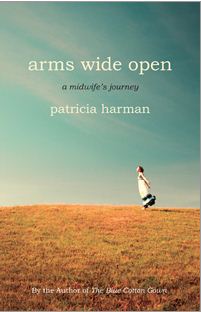Summer Reading: Arms Wide Open ~ A Midwifes Journey
By: Kimmelin Hull, PA, LCCE | 0 Comments
Arms Wide Open: A Midwife Journey (Boston, Beacon Press) by  Patricia Harman,CNM, is more than a memoir tailored to female sensibilities. It is a counterattack to the construed version of pregnancy, birth and womanhood that so many media outlets insist upon perpetuating.
Patricia Harman,CNM, is more than a memoir tailored to female sensibilities. It is a counterattack to the construed version of pregnancy, birth and womanhood that so many media outlets insist upon perpetuating.
A year ago, I wrote a post about how pregnancy, labor and birth are portrayed in the popular media, and the damage those Hollywood-esque images inflict on the collaborative female psyche. When I find a good film, article or book (novel or NF) that portrays childbearing in a fair light, I get awfully excited.
Patricia Harman isn't new to writing about life as a midwife. Her debut book, The Blue Cotton Gown, describes her work as a nurse midwife in a West Virginia women's health clinic with her obstetrician husband, Dr. Tom Harman. In Arms Wide Open, the author-drawing on journal entries from her past-brings the reader through her early years of sustainable, off-the-grid living in the northern Minnesota wilderness, as well as on a commune in West Virginia, and the series of events which led to her eventual career as a midwife. While much of the book does not focus on childbirth, the birth scenes peppered throughout offer hope and sustenance to readers new and old to the normal birth movement.
Following the birth of her first son, Harman became interested in teaching other women about labor and birth as a means of sharing the empowered awareness she, herself, entered her first experience with. The descriptions of her childbirth education sessions are both simple and profound:
"So here's the deal,- I tell everyone sitting on the floor and sofas of the community room at the library. "There's nothing magical about childbirth breathing. It just keeps you calm and gives you something to do when you want to run away, which you can't, so you might as well settle down and do your job." (p. 38)
Teaching these community classes shortly after Lamaze International would have gotten its start, Harman seemed to have approached childbirth education in the most germane manner: women sharing wisdom with other women. No fancy power point slides. No exorbitant class participation fees. Advice recited in the memoir from Harman's past is as relevant today as it was when delivering it to her commune friends and nearby community members nearly four decades ago:
"I havent had much pain in my life, but [childbirth is not] like getting your arm cut off. It's a different kind of pain, and if you know what to expect, it's not bad...I mean, my labor was long and hard and it hurt more than I imagined, but I survived. You could do it...You just have to get your mind out of the way; your body knows what to do." (p. 70)
When I think of the messages popular media relay about labor and birthscenes full of screaming women, panicked partners and maternity care providers expecting the worst of the worst, I regret the influence these images have on the girls and women who view them. It doen't take much just one vivid scene in a TV show representing birth as a bomb waiting to detonateand an impressionable mind is forever scarred into believing that birth is always anything but normal.
Following her progression from a self-taught home birth midwife to a certified nurse midwife, Arms Wide Open depicts an ideal clinical situation in the partnership Harman has struck with her physician husband-who attended numerous births with her prior to uncovering his own interest in practicing medicine. And yet, this book is not about glossing over the harsh realities that do sometimes haunt the childbearing. Breech births, leaking amniotic fluid, precipitous deliveries, fetal death, prolonged ruptured membranes with meconium staining...rather than pretend that these complications never exist, Harman acknowledges her experience with them, and the sometimes dicey experiences that accompany the work of a homebirth midwife. Nonetheless, the reader still comes away with the overall impression that, when properly supported, pregnancy and birth will inherently go well a majority of the time:
"Mara delivers the infant into my hands, first the head with its chubby cheeks, then the shoulders, then the rest. Her body works perfectly to produce this new life and I remember that this is the way it's supposed to be. This is the way, if not interfered with, most women can give birth." (p. 173)
Published: July 05, 2011
Tags
Maternal Infant CareArms Wide OpenBlue Cotton GownCNMCommune LivingMidwiferyPatricia Harman